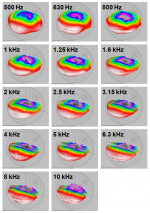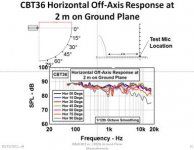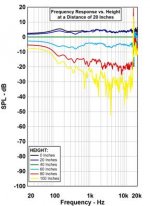Further clarification, in reality a phase plug is simply a diffration device located close to the diaphram? Sort of a weasel word instead of the hated "diffraction" word, but serving the purpose of reducing small wave cancellation across the diameter and equal to the size of the diaphragm via diffraction? Therefore, if I'm getting this right, *almost or all* compression drivers *begin* life at the horn entrance with an already severely diffracted wave? Now this one just might be nut-slicer question, can barely believe I know enough to ask it!
Only two possibilities then:
1). All compression drivers sound bad.
or
2). Diffraction isn't necessarily a bad thing
Hello Dave
I think it depends on just how it's done. I use horns and waveguides that by strict definition are diffraction devices that sound very good and don't have any issues when you turn things up. To say that they are all bad is just an extreme position and does not help explain why some sound good and others don't.
Rob🙂
2). Diffraction isn't necessarily a bad thing
I think it depends on just how it's done. I use horns and waveguides that by strict definition are diffraction devices that sound very good and don't have any issues when you turn things up. To say that they are all bad is just an extreme position and does not help explain why some sound good and others don't.
Rob🙂
Here's a 3D polar of a smaller CBT prototype. Measured by Ron Sauro and NWAA Labs. More smoothing is used here though. The smaller CBT looses it's directivity earlier then the CBT36 or other larger CBTs.Looks very well behaved in every way. Very interesting that the response stays so flat over such a wide range of listening heights and distances.
David
Attachments
As demonstrated by CBT, and all speakers to some degree, diffraction and diffraction type effects may occur without notice; Stereo speakers are effectively very much a two slit diffraction grating, where a single source is split into two. Linear superposition accounts for resulting radiation pattern.
These are linear phenomenon.
In compression driver system, air is driven into non linear behavior. Loading in horn mouth becomes position sensitive, and signal dependent. Standing wave interference patterns, and traveling wave interference patterns are set up in horn with dependence on both frequency and amplitude.
Net result is that radiating wavefront shape changes with amplitude for any given signal waveform.
This is core of compression driver sound. It leads to complex reordering of spatial cues. Auralization techniques based on single point measurement mask both the non linearity of hearing response, and loss of compression driver's behavior as fixed location in space. This is readily confirmed by consistent observations that perceived changes of sound character of live setup are always greater than perceived changes heard with auralization techniques.
Compression drivers are not alone in creating dynamically changing wavefront, direct radiators deviating from piston behavior also do this.
These are linear phenomenon.
In compression driver system, air is driven into non linear behavior. Loading in horn mouth becomes position sensitive, and signal dependent. Standing wave interference patterns, and traveling wave interference patterns are set up in horn with dependence on both frequency and amplitude.
Net result is that radiating wavefront shape changes with amplitude for any given signal waveform.
This is core of compression driver sound. It leads to complex reordering of spatial cues. Auralization techniques based on single point measurement mask both the non linearity of hearing response, and loss of compression driver's behavior as fixed location in space. This is readily confirmed by consistent observations that perceived changes of sound character of live setup are always greater than perceived changes heard with auralization techniques.
Compression drivers are not alone in creating dynamically changing wavefront, direct radiators deviating from piston behavior also do this.
It is my understanding that phase plugs are really diffraction devices,
No, this is not the case. A good phase plug should present a wavefront to the throat of the following device that allows this second device to utilize this wavefront to the greatest extent possible. For the most part this is a flat uni-phase wave, but there is nothing that requires this, its just what virtually all devices claim to do. This wavefront then allows for the least generation of HOMs in the following device, depending on the design of the following device. Thus its proper design should minimize diffraction in the system not the other way around.
Ideally, it turns out, that the wavefront at the drivers aperture should not actually be flat, but that's another story far too complex to get into here.
Last edited:
As demonstrated by CBT, and all speakers to some degree, diffraction and diffraction type effects may occur without notice; Stereo speakers are effectively very much a two slit diffraction grating, where a single source is split into two. Linear superposition accounts for resulting radiation pattern.
These are linear phenomenon.
In compression driver system, air is driven into non linear behavior. Loading in horn mouth becomes position sensitive, and signal dependent. Standing wave interference patterns, and traveling wave interference patterns are set up in horn with dependence on both frequency and amplitude.
Net result is that radiating wavefront shape changes with amplitude for any given signal waveform.
This is core of compression driver sound. It leads to complex reordering of spatial cues. Auralization techniques based on single point measurement mask both the non linearity of hearing response, and loss of compression driver's behavior as fixed location in space. This is readily confirmed by consistent observations that perceived changes of sound character of live setup are always greater than perceived changes heard with auralization techniques.
Compression drivers are not alone in creating dynamically changing wavefront, direct radiators deviating from piston behavior also do this.
Lots of fancy assertions here but I'm not sure the facts would back them up.
Certainly over the normal range of operation we do not see polar patterns changing with level for either horns or direct radiators. Levels in the throat are quite high and we can measure a fair amount of 2nd order distortion from that, but more pernicious effects are fairly rare at average levels.
Diffraction simply refers to the bending of sound around a solid object. It is neither good nor bad on its own. Without it we wouldn't hear sound (at least low frequencies) to the side or the rear of a speaker. Usually when we refer to diffraction we are talking about artifacts from reflections related to diffraction. These may be bad or benign based on level, delay time and arrival direction.
"Complex reordering of spatial cues"?
David
Considering it's a polar response, it's measured at all heights/angles from what I understand.Ohmolt - thanks for the plot. Do we know at what height that was measured?
Here's some additional info from Keele:
A CBT prototype of 2003. Note that this prototype is quite similar to the CBT36 and uses essentially the same tweeters and spacing that the current CBT36 uses. This array is a 60 deg circular-arc 1m-tall free-standing array.
Below are the polar balloons for the small-driver array copied from the poster. Note that the equivalent free-standing CBT36 array (two arrays mounted bottom-to-bottom) is over 3 m (10 ft) tall and provides control down to 100 Hz rather than 500 Hz. Note that these measurements are of a free-standing CBT array. The upper half of these balloons represent the above-floor response of a ground-plane array.
Note that these balloon measurements indicate a uniformity of coverage with frequency that exceeds even the best CD horns.
Regarding the horizontal measurement from the CBT36 vs B&W Matrix below, Don has also commented something that I think is well worth mentioning.
The slide shows responses measured with the test mic on the floor. The 90° curve rolls off above 5 kHz because of roughness of the concrete floor in our shop. Measured over a shiny tile floor it’s essentially flat!
In lieu of these measurements, the attached CBT36 simulations show essentially the same thing but simulated at several distances from the base of the array at 0.5, 1, 2, 3, 10, and 250 m. The simulations of course do not include box diffraction effects. Note that the aspect ratio of all graphs is 25 dB/decade.
Here’s the graph at 2 m from the base of the array and 75° off-axis horizontal:
The red curve is at a height of 2 m which is 0.5 m above the top of the array (array is 1.5 m tall) and is fully 10 dB below the 1 m listening height level! All curves are normalized to the response at 1 m high (green response curve) at that specific angle. Note that the level increases towards the floor (black, blue curves) but dramatically decreases as you go up (blue, red, and yellow curves).
Here’s the corresponding 75° curves, but much closer to the array at 0.5 m. Note that the 1.5 m level at the top of the array (blue) is 6 - 7 dB below the level at the listening height of 1 m. At a point igher at 0.5 m above the top of the array (red), the level is down some 15 to 20 dB but still fairly flat!
So what’s the conclusion? Yes the CBT36 does illuminate the walls, but with essentially a spectrum that is quite flat and that decreases considerably with height at distances particularly close to the array.
The behavior of the CBT36 over the ground is completely unique and is dramatically different and extraordinarily better than any speaker that has come before!! Just repeat the same set of over-the-floor measurements on any other manufacturer’s speaker and you will find out!
Sure, a little bit of commercial at the end but I personally can say that I've never had a speaker with such a flat response in the room. I've also measured it at different places off-axis in the room and it's simply amazingly smooth. When measuring at the center in front and back in the room, it hardly changes at all above schroeder. It's also flatter to the sides then other speakers I've had and measured. And vertically we know it's strength. Hardly changes there too.
I'm not saying it's a perfect speaker for everyone. That depends on the application. But I've very surprised it hasn't gotten more attention. It's really a break through in speaker design. And the CBT36 kit is an absolute bargain. I think many are too obsessed with the fact that it disperses wide, and forget it's uniformity and that it avoids vertical reflections to a large degree. The fact is that overall, you need less treatment in the room for great imaging compared to most speakers and it's maybe the only speaker that can also yield a true spacious soundfield with very little coloration if that's wanted.
I can't wait for future CBTs with even better and more sensitive drivers. 🙂
Attachments
This is extremely short-sighted, to say the least.
About 15% of this new user's posts are new topics and three of them have been closed, probably a fourth on the way. 😉
IG
Further clarification, in reality a phase plug is simply a diffration device located close to the diaphram?
I'm not certain we can talk about diffraction when the acoustic space is not large enough to be significant wrt the wavelengths involved.
IG
This would happen naturally for a spherical direct driver. This with a spherical wave guide would be a good half way house to a compression driver without a phase plug, giving less problems but not the gain of a compression driver in a purpose designed OS or JMLC horn. The directivity is becoming more important to me in WAF scenario - no wall drapes high RT60.Wavefront entering horn should be spherical. Certainly true for conical waveguide.
Last edited:
Thanks Omholt. I remember Don talking about the changing polar response with height, and seeing it in some of his presentation materials. It was easy to hear just by walking around the speaker and listening at various heights.
This would happen naturally for a spherical direct driver. This with a spherical wave guide would be a good half way house to a compression driver without a phase plug, giving less problems but not the gain of a compression driver in a purpose designed OS or JMLC horn. The directivity is becoming more important to me in WAF scenario - no wall drapes high RT60.
That's not true for a vibrating spherical cap since its motion is axial - not normal to the surface. There is no waveguide geometry that fits this wavefront. Only a radially vibrating spherical surface is a match to a conical horn, but I have no idea how one would make something like that.
Wavefront entering horn should be spherical. Certainly true for conical waveguide.
Yes, that's true. That's because a conical horn is based on a spherical coordinate system.
Ideally, it turns out, that the wavefront at the drivers aperture should not actually be flat, but that's another story far too complex to get into here.
Well, yeah, if the horn is based on an elliptical coordinate system, like (OS) oblate spheroidal, (PS) prolate spheroidal or (EC) elliptic cylindrical coordinate systems, then the presented wavefront would ideally be elliptical too.
Of course, what comes out of a compression driver approximates a plane wave. But that's pretty close to what is needed at the throat of most horns. I'd say there are a lot of other things that are more of a compromise than this.
I wouldn't say loudspeakers are completely trivial to design, but I also wouldn't say there is any aspect that is "far too complex to get into here."
This is a world with systems built using thousands of man-years of effort, built upon preceding systems with thousands of man-years of effort. Those are truly complex systems, and it's humbling to work with them.
Loudspeakers just aren't all that complex, so I suppose maybe that's why it is easy to make the mistake of getting all cocky about them.
constant directivity corner horn
Are there a lot of horn like that in shops ? For 1" or 1,5 " (or 2" with 1,5" reduction) ? Famous Seos can do the job ?
Are there a lot of horn like that in shops ? For 1" or 1,5 " (or 2" with 1,5" reduction) ? Famous Seos can do the job ?
Only a radially vibrating spherical surface is a match to a conical horn, but I have no idea how one would make something like that.
A pump pressurizing a hollow spherical elastomer (like a baloon) would do it. The pump could be driven using a linear motor. Easy peasy.
Not sure a spherical elastomer driver would give much benefit over current (piston) driver configurations, but it would be no trouble at all to make, certainly for low and midrange frequencies.
However, I don't think the diaphragm shapes and driver configurations we currently use are all that compromized. You must agree, since you use these devices in your systems. I know the wavefronts they create do not have pristine shapes but instead are approximations. I still think they work very well.
Again, I think there are design choices and compromises made in other aspects of loudspeaker design that are a lot more significant.
Only two possibilities then:
1). All compression drivers sound bad.
or
2). Diffraction isn't necessarily a bad thing
Precisely what I was thinking. This is my ownl
Are there a lot of [constant directivity cornerhorns] in shops ?
The only commercially available constant directivity cornerhorns I'm aware of are the ones we make.
So few rooms support this configuration it's just not very popular.
I kind of see it as more a custom installation or DIY thing. When you can do it, it's great.
- Status
- Not open for further replies.
- Home
- Loudspeakers
- Multi-Way
- The dirty little secret of horns.



